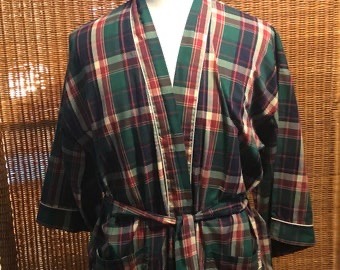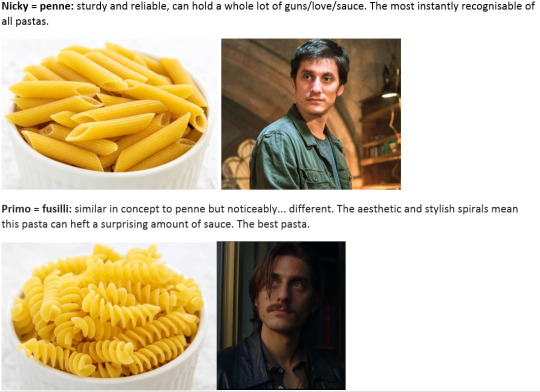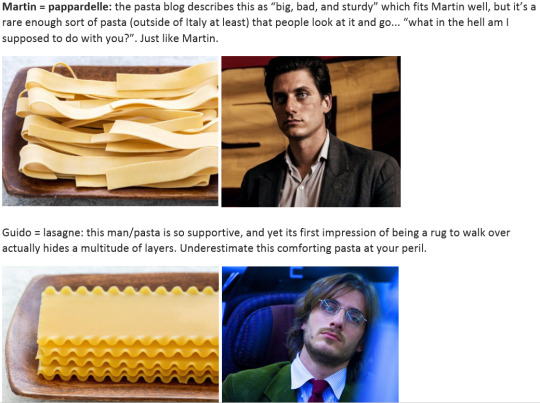#more posts about richard than either nicky or joe
Text

I posted 1,171 times in 2021
205 posts created (18%)
966 posts reblogged (82%)
For every post I created, I reblogged 4.7 posts.
I added 517 tags in 2021
#art - 241 posts
#lmmbingo - 54 posts
#the old guard - 47 posts
#richard - 37 posts
#ask - 25 posts
#nicolo di genova - 25 posts
#tog fanfic - 25 posts
#luca marinelli - 23 posts
#joe x nicky - 21 posts
#yusuf al kaysani - 19 posts
Longest Tag: 132 characters
#meanwhile also picture andy in a vinyard somewhere with quynh getting shitfaced off bad fruit wine and reading the latest periodical
My Top Posts in 2021
#5
Still thinking about Nicky and Joe letting the old man side come through even though they look 30 and can’t get the image of them shuffling off to bed together dressed like this out of my mind:


157 notes • Posted 2021-11-27 20:15:27 GMT
#4
A ficlet based off a post I made earlier about Joe and Nicky swapping sun/moon imagery with each other. I could imagine canon Joe with rings or necklaces with the moon incorporated into them, or AU Joe with moonstone earrings or moon phase tattoos, but I wasn’t sure what would fit Nicky. And so I wrote this:
“What’s your favourite colour?” Claudia asks, her voice pulling Nicky out of the light doze he’d fallen into as their train speeds through the countryside.
“Hmm? Oh, I don’t really have a favourite colour,” he says, offering the child a rueful smile.
“Everyone has a favourite colour,” she tells him firmly. Nicky laughs.
“How about... blue.”
Claudia grins. “Blue is a very nice colour. Probably my second favourite.”
“What’s your first favourite?”
“Red,” Claudia says decisively. “Like strawberries.”
She pulls down the little tray table from the seat in front of her and solemnly lays out a series of brightly coloured threads, selecting a light and a navy blue from her hoard.
The bracelet making kit had come from Andy, who’d been waiting for them at the train station and had clearly spent too much time in the newsagents.
“It’s a long journey, and kids get bored,” she’d said, giving Claudia a grin as she handed the kit over. Nicky decided not to mention the colouring book and ziplock bag of Lego he already had in his backpack- Andy seemed pleased with herself, and Claudia was delighted with her gift.
“I’m going to make Mama one when I see her again,” Claudia chatters as she starts to tie knots in the thread. “Her favourite colour is purple. She has a lot of bracelets already, but I think she’ll like mine.”
“I’m sure she’ll love it,” Nicky replies, silently relieved that Joe had messaged not half an hour earlier to say that he’d already taken Claudia’s mother to the safe house. Claudia seems blissfully unaware of the danger she and her family are in, and Nicky would like to keep it that way.
Claudia hums as she twists the threads together, and Nicky is almost on the verge of drifting off again when she asks: “What charm do you want?”
Nicky opens his eyes to find that she’s upended the small box of brightly coloured plastic charms onto the table. There are hearts, and rainbows, and animals, and...
“Could I have this one, please?” Nicky asks, pointing to the charm he’d like.
Claudia nods, and threads it onto the bracelet, tying it into place.
“Here we go,” she says triumphantly, holding out the finished bracelet. “Gimme your hand.”
Nicky obligingly holds out his hand and lets her ties the bracelet around his wrist, thanking her as she sits back to already start work on another. He smiles, watching her grab the purple threads, and touches the yellow smiling sun charm on his bracelet as he closes his eyes once again. He’ll be with Joe again soon.
159 notes • Posted 2021-04-22 20:13:08 GMT
#3
Today in niche content no one asked for: The Old Guard as crimes and misdemeanours of my family over the years
Andy: Forged Lebanese driving license that turned into an underserved British license
Nile: Smuggled a shot of vodka into a football game by disguising it in a tampon wrapper
Joe: Scaled the walls of the British embassy in Egypt in order to steal their flag and humiliate them
Nicky: Accidentally stole a hymn book from Church because he got distracted and forgot he was holding it
Booker: Started a Victorian dating agency that scammed people by promising to find them a perfect match but in actuality just took their money and ran
Quynh: Diamond theft
203 notes • Posted 2021-04-27 17:38:37 GMT
#2
@kiaya mentioned that between Marwan’s pecs and Luca’s thighs they make a top+bottom pair, and so pyjama sharing happened:
Andy, Nile was pretty sure, predated shopping lists. Which went some way to explaining why the scrap of paper she handed to Nile a) wasn’t even a list and b) made no sense at all.
“Okayyyy...” Nile mused as she turned the paper round, making sure she hadn’t missed anything. “Well first of all, you don’t just ‘buy an internet’.”
Andy made a dismissive noise and handed Nile another 500 Euro note as if that solved the issue. Nile didn’t have the energy to argue the point, and instead moved on to her next question:
“I’m not sure I can get Pirozhki here either, this village only has one store and it’s pretty tiny. And French.”
“Just do your best,” Andy said warmly.
“And,” Nile continued, hitting her stride, “you’ve written ‘2 pyjamas’ when there are, in fact, four of us.”
“Yes, but I don’t wear pyjamas,” Andy pointed out.
“That still doesn’t add up.”
“Oh you don’t either? Make it just the one set then.”
Nile took a long, slow breath. Maybe either Nicky or Joe already had a pair, or like Andy didn’t subscribe to the notion of night clothes. Either way, asking questions about the ‘list’ only seemed to confuse things further, so she grabbed her jacket and headed out into the cold.
*****
Joe was only wearing pyjama trousers. Nile felt a little bad.
“I’m sorry, did the top not fit?” she asked. “Sometimes people try things on and put them back in the wrong places, I should’ve checked the label instead of trusting the hanger.”
“No, no, it fits perfectly,” Joe reassured her with a smile. “Thank you, Nile.”
Maybe Joe just didn’t like wearing tops in bed. Nile had an ex like that- he always complained about overheating and never wore any sort of tshirt to sleep. She settled back onto the sofa and thought no more of it, working her way through a bowl of what she thought was granola but may well have been bird feed. Her French was a little rusty and the store had been laid out in a similar fashion to Andy’s list: anything and everything spread out in a jumble.
“Good morning, Nile,” Nicky greeted her as he ambled into the kitchen.
“Mornin’,” Nile replied, then froze for a second as everything finally clicked into place: Nicky was wearing the pyjama top. Ah. That made sense.
“What makes sense?” Joe asked, handing Nicky a cup of coffee.
Damn, Nile hadn’t realised she was thinking aloud.
“I just thought it was weird, initially, Andy telling me just to buy one pair of pyjamas for the two of you.” Nile swallowed her bird feed. “But this makes sense. It’s kind of cute, really.”
“Mmm,” Joe agreed absently, his eyes firmly fixed on where Nicky’s top rode up as he reached up for the bowls on the top shelf. He was wearing boxers underneath, thank goodness, but the way Joe’s eyes glazed over it was like Nicky was wearing nothing at all.
“Told you the top fitted perfectly.”
448 notes • Posted 2021-02-08 16:28:20 GMT
#1






Bingo prompt 5: pasta. Make of this what you will.
804 notes • Posted 2021-06-06 11:05:03 GMT
Get your Tumblr 2021 Year in Review →
#my 2021 tumblr year in review#more posts about richard than either nicky or joe#that figures#also ofc pasta was the number one post#just as pasta is number one in my life
10 notes
·
View notes
Note
What weapons were used during the Crusades? I remember something vaguely about bows/crossbows being important but nothing else. Thank you :D
Nonnie, if you are (as I suspect) asking this for Very Important Fic Research Purposes, let me just say: you, my good gentleman/lady/nonbinary pal/mineral/vegetable, are Extremely Valid, and I salute you utterly. Let us just quietly assume that is in fact what you are doing. Buckle up, because yes. You have to consider individual and collective weaponry, differences in Christian vs. Muslim armies, tactics, and their development over the crusades. Never fear, I am here to make it entertaining (ish) for you. Let’s start with the individual warriors.
How To Arm Your Crusader: Nicky Edition
First! Nicky is from Genoa, which was most notably involved in the First and Third Crusades. I mention this because if you’re deciding to place him among a contingent of his fellow countrymen, it’s useful to know where you can most easily do that and where it would be most realistic to have them fighting. It will also make a difference for what he’s armed with. You are correct about crossbows being one of the major weapons of the crusades; indeed they were so effective in medieval warfare generally that the church tried to ban them, at the Third Lateran Council in 1179, from being used on fellow Christians. (Muslims were still fair game.) Longbow archers were used occasionally (though it wasn’t until the 13th century, mostly after the end of the crusades, that they became a major battlefield force), but Nicky would definitely be a crossbowman or at least know how to use one, because we have multiple mentions of Genoese crossbowmen in the sources. (Me in the shower this morning: YOU IDIOT OF COURSE HE’S A CROSSBOWMAN! YOU SEE HIM WITH A LONG RIFLE AND EVERYTHING!). Notably, Richard the Lionheart fought the Battle of Jaffa (1192) with 54 Genoese crossbowmen, about 100 knights, and 2 horses. It is up to you if you decide to use this fact or not, ahem.
Crossbows are easier to learn how to use than longbows, but require strength to wind the mechanism and launch the bolt. There is also a more powerful version called the arbalest, which had a frame made of metal instead of wood. These also had a longer range, so they were in fact a bit like the assault rifles of their day. Unlike a rifle, however, you have to have enough time to fire the weapon (which takes a while) and therefore it’s not as useful if the enemy is right on top of you. They’re most helpful in attacking an enemy in a more stationary position (such as, say atop a tower or a wall) and where you can have enough space to reload without being overrun.
We see that Nicky has a broadsword, which would also be a fairly standard weapon for a crusader. Most boys started their training at the age of 7, and the value in achieving the rank of knighthood would rise steadily over the course of the crusades, complementing the development of the ethos of chivalry. At the time of the Norman Conquest (1066), we could still have “free” or “unfree” knights, and it was a mark of military service rather than a distinct social rank. But with the popularity of chivalric literature in the 12th century, the ideas and prestige associated with knighthood skyrocketed. I know I’ve written some posts about this somewhere, which I’m too lazy to go find right now, but you can possibly find them in my medieval history tag. In essence, chivalry means martial prowess. It has a more romanticized aspect, of course, but it’s mostly about kicking ass, though it does prescribe certain codes of conduct for combatants (on both sides) and for noble-born women, as well as a strong religious aspect. If you do want more info on this and how to avoid the stereotypes of a chivalric knight, let me know and I’ll go dig up my old stuff.
There’s also a big difference between fighting on foot (infantry) and fighting on horseback (cavalry). All the footsoldiers were a lower or more common rank, and if you had a horse, you were almost certainly a knight or a professional soldier. Footsoldiers usually were pike (spear)men, since even if you only have long spears and a shield wall, you can throw together a pretty awesome defense. (At the Battle of Hastings, English fyrdmen with just pikes and shields almost defeated multiple Norman heavy cavalry charges.) Plus, a spear doesn’t take too much special training: just poke the sharp end into the other guy, as Jon Snow might say. Hence it was easier for non-professional soldiers or citizen conscripts to use it rather than the more specialized skills for knights.
The best warhorses were known as destriers. They were specially trained to kick, bite, and raise as much hell as their masters in battle; they were expensive and prized. A fast, strong horse often also used for war or for fast travel is a courser. A horse for non-battle or basic transport situations would be a palfrey or a rouncey (though lower-status men-at-arms could also ride one in battle). We can decide whether or not Nicky has one of these.
Armor! The Christian crusaders wore steel (chainmail) which was a major advantage in close-quarters combat. This is not the plate armor you may be thinking of, since full-body armor didn’t get used until around the 14th century at the earliest and came into full vogue in the 15th/16th century (by which cannons had often made it obsolete and dangerous). Chainmail is no joke: it weighs at least thirty pounds and boys had to wear it from childhood to know how to stand up in it, let alone move. (I.e. all those movies where anyone just slaps it on and is fine are liars.) You would wear several layers: first an undertunic, then a padded leather gambeson, the steel hauberk itself (often thigh-length), and then a cloth tabard on top, which displays your badge or flag or your cross, if you’re a crusader (though these were far from ubiquitous and sometimes color-coded by country). That way people can also tell which side you belong to. You wear a helmet on your head (obviously), vambraces and gloves on your arms, and greaves on your legs, over heavy leather boots. Now imagine all that coming at you with a spear on a charging warhorse.
.... what I��m saying is, medieval knights could kick your ASS.
You can also use daggers, hatchets, and other small arms (morningstars are cool, but alas, were never really used in the field). A knight sometimes carried a special blade known as a misericorde, which had the gruesome but necessary purpose of finishing off a wounded enemy (or friend) who hadn’t died immediately from their injury but wasn’t going to survive it either. Welp.
And with that:
How To Arm Your Muslim Warrior: Joe Edition
So we’ve got Nicky sorted: what about his More Than Boyfriend mortal enemy? Well, for the most part, it will look something like the above. Christian crusaders of the period would have called Muslims “Saracens,” which was the name for them, along with less flattering things (heathens, infidels, etc) but when in doubt, if writing from a crusader POV, you can just use Saracens. Actual Muslims obviously never use this word to refer to themselves. They did not have crossbows, but rather shorter and more mobile bows that were designed to be used from horseback. Arabian horses were smaller in stature than European destriers, but faster and more maneuverable, and had a legendary reputation for speed and temperament. Muslim forces would also sometimes ride to the battlefield and then dismount to fight.
We see that Joe has a sword with a shorter and wider/slightly curved blade in comparison to Nicky’s long, straight broadsword. In my fic, I call this a saif, which is just the Arabic word for sword and is how Muslims of the period would have referred to it (the word “scimitar” is from an Italian name for it and wasn’t used until at least the 16th century). It can mostly refer to any Islamic sword in this style, though there are different names for regional variations. If you want to give him a really cool and culturally significant weapon (especially since I headcanon him as a Fatimid Shia Muslim from Egypt), you could give him the zulfiqar, which was a double-pointed sword used by Ali ibn Abi Talib, a cousin of Prophet Muhammad and one of the main figures in Shia Islam. It is often represented on flags and in battlefield invocations. The actual zulfiqars that exist are more often dated from the 16th/17th century with the Ottomans or from 19th-century Persia, rather than from the crusades, but hey, you can always say that Joe had something to do with that. Sidenote, research the differences in the various Muslim dynasties of the crusader period, as they’re definitely not one size fits all (especially in re: the prominence of Sunni sultans in the later crusades, and how Joe might have thought about that).
As noted, the Muslims didn’t wear steel armor, which was a disadvantage to them in close-quarters combat with crusaders. Their armor was made of boiled leather and lamellar scales, designed to be light and good for long-distance riding rather than a heavy battle. They would also have helmets (in various shapes and styles), gloves, etc. An archer would have a quiver and have to think about using, reclaiming, or mending arrows after a battle (the Never Ending Quiver in every movie ever: ALSO WRONG).
I will confess that I don’t know as much about Islamic warrior ethoi comparable to chivalry as I should. However, the crusades were taking place against the backdrop of the Islamic Golden Age, in which the culture, sophistication, and scholarly study in the Islamic world was at its height, and there are plenty of artists, poets, mathematicans, and philosophers that Joe would be familiar with, that would guide his actions in the way that chivalry might for a knight. Such as, for example, Avicenna (Ibn Sina) from Samarkand, or the Banu Musa brothers of Baghdad. There would also obviously be the Qur’an and the ahaditha (sayings of Prophet Muhammad) and other religious texts and traditions. Obviously if you’re going to use any of these, be respectful, do your research, and present it in a positive way.
And then of course there is the:
Big-Ass Cool Weapons of Major Boom
So what else do we have on a large scale, aside from the individual warriors? For a start, we have (on the crusader side) siege engines, such as mangonels, trebuchets, towers, etc. These are not comparable to the Return of the King-esque “break off a chunk of the city with every hit,” but they were pretty damn effective; during the Third Crusade, one stone from a trebuchet was reputed to have killed twelve people in the market in Acre. Richard the Lionheart also hauled along a lot of high-quality stone from Sicily to make better missiles than the soft crumbly sandstone of the Holy Land. There’s a reference to a “cat,” which seems to have been a tower containing multiple compartments for crossbowmen, which could be pushed up against city walls. There are also battering rams and other blunt-force weapons, since sieges were a main part of every crusade. (In fact, commanders tried to avoid open battles as much as they could, though there were also usually at least one on each crusade.) Defensive strategy included digging deep ditches around walls, to prevent your opponent’s siege engines from getting too close, or just throwing stuff down at them as they tried to climb with scaling ladders. With this, we also have....
Greek fire! It’s semi-similar to wildfire from Game of Thrones, even if not quite as effective, but still a pretty cool weapon. The Muslims used it first; it didn’t enter Christian warfare until Geoffrey Plantagenet introduced it in 1151 (his grandson, Richard the Lionheart, also got to be rather fond of it). It was a long-burning liquid explosive that could burn even on water and couldn’t be put out by regular means; it was very feared and very effective. So if you were under siege and had some of that stuff to pour down on the defenders, it would be useful (along with boiling pitch, oil, or other more ordinary substances). Your enemy might plan for that or try to defend against it by using hides soaked in water or some other kind of shield.
Anyway, I’m sure there is more I could say here, but this is already MORE than long enough. I hope it is helpful to start with. And inspirational. Ahem.
336 notes
·
View notes
Text
The first image that comes to mind when I think of Cary Grant is the classy gentleman that ultimately became his signature style. Most brilliant of all in Grant’s impressive repertoire perhaps was his ability to add the bumbling to the suave sophisticate. That’s the man I adore, but that man didn’t come about easily. It was hard work and perseverance that led to the archetype that’s still recognized as the domain of just one man. One.
Cary Grant was born Archibald Leach in Bristol, England on January 18, 1904. From 1932 to 1966 he appeared in over 70 motion pictures becoming one of the greatest movie stars in the world. Ever. And that’s not an exaggeration as you well know. Beloved and admired by the masses and his peers Grant mastered various film genres turning in memorable performances in broad comedies, murder mysteries, adventure stories and romances.
On that road to becoming Cary Grant the image, Cary Grant the actor played men with numerous careers and from different walks of life. It’s quite the impressive resume, one that goes well beyond a gorgeous exterior. Why don’t I show you?
The Cary Grant Résumé
Cary Grant
1 Handsome Movie Star Way, Hollywood, CA 01184 – (000) 227-9472 – [email protected]
Summary:
At least twelve rich, playboy types if you don’t include the five successful businessmen.
Ten soldiers
Six newspaper men/writers
Six doctors/scientists
Five artistic types
Four government agents
Three pilots
Three advertising executives
Two supernatural beings
One Earl, a policeman, an engineer, a lawyer, an economist, a politician, a few unsavory types, half a dozen or so times involved in espionage.
The handsome, rich bachelor often, but was also a loving husband and father to several women and numerous children
Highlights:
Hard-working and reliable
Energetic, well-executed pratfalls
Distinctive double-take
Proficient at fast-talk
Style Icon
Unique voice
Exceptional romantic skills
Great with pets and children
*Experience:
Rich men and playboys (1932 to 1962)
Philip Shayne in Delbert Mann’s That Touch of Mink (1962)
Johnnie Aysgarth in Alfred Hitchcock’s Suspicion (1941)
C. K. Dexter Haven in George Cukor’s The Philadelphia Story (1940)
Alec Walker in John Cromwell’s In Name Only (1939)
Jerry Warriner in Leo McCarey’s The Awful Truth (1937)
Ernest Bliss in Alfred Zeisler’s The Amazing Adventure (1936)
Gerald Fitzgerald in Elliott Nugent’s Enter Madame! (1935)
Jack Clayton in Wesley Ruggles’ I’m No Angel (1933)
Jeffrey Baxter in Paul Sloane’s The Woman Accused (1933)
Romer Sheffield in William Seiter’s Hot Saturday (1932)
Charlie Baxter in Dorothy Arzner’s Merrily We Go to Hell (1932)
Ridgeway in Alexander Hall’s Sinners in the Sun (1932)
This slideshow requires JavaScript.
Businessman (1934 to 1966)
Sir William Rutland in Charles Walters’ Walk Don’t Run (1966)
(and widower) Tom Winters in Melville Shavelson’s Houseboat (1958)
Clemson Reade in Sidney Sheldon’s Dream Wife (1953)
Julian De Lussac in Frank Tuttle’s Ladies Should Listen (1934)
Malcolm Trevor in Lowell Sherman’s Born to be Bad (1934)
PS – If you’re thinking that Cary Grant as business man looks very similar to Cary Grant rich playboy – well, yeah.
Men of science (1934 to 1951)
Physician, Dr. Noah Praetorius in Joseph L. Mankiewicz’s People Will Talk (1951)
Chemist, Dr. Barnaby Fulton in Howard Hawks’ Monkey Business (1952)
Neurosurgeon, Dr. Eugene Norland Ferguson in Richard Brooks’ Crisis (1950)
Pediatrician, Dr. Madison Brown in Don Hartman’s Every Girl Should Be Married (1948)
Paleontologist, David Huxley in Howard Hawks’ Bringing Up Baby (1938)
Plastic Surgeon, Dr. Maurice Lamar in Harlan Thompson’s Kiss and Make-Up (1934)
Soldiers (1932 to 1959)
Lt. Cmdr. Matt T. Sherman in Blake Edwards’ Operation Petticoat (1959)
Cmdr. Andy Crewson in Stanley Donen’s Kiss Them for Me (1957)
Anthony in Stanley Kramer’s The Pride and the Passion (1957)
Captain Henri Rochard in Howard Hawks’ I Was a Male War Bride (1949)
Captain Cassidy in Delmer Daves’ Destination Tokyo (1943)
Sergeant Cutter in George Stevens’ Gunga Din (1939)
Captain Andre Charville in George Fitzmaurice’s Suzy (1936)
British Officer, Micahel Andrews in Charles Barton’s and Louis J. Gasnier’s The Last Outpost (1935)
Lietenant B. F. Pinkerton in Marion Gering’s Madame Butterfly (1932)
Lt. Jaeckel (naval officer) in Marion Gering’s Devil and the Deep (1932)
This slideshow requires JavaScript.
Writers and newspaper men (1934 to 1944)
Mortimer Brewster in Frank Capra’s Arsenic and Old Lace (1944)
Reporter, Roger Adams in George Stevens’ Penny Serenade (1941)
Patrick “Pat” O’Toole in Leo McCarey’s Once Upon a Honeymoon (1942)
Walter Burns in Howard Hawks’ His Girl Friday (1940)
Reporter Charlie Mason in Richard Wallace’s Wedding Present (1936)
Newspaper publisher, Porter Madison III in Marion Gering’s Thirty Day Princess (1934)
Spies or government agents (1933 to 1964)
Including this one because it borders on “spying” – Walter in Ralph Nelson’s Father Goose (1964)
Peter Joshua in Stanley Donen’s Charade (1963)
Devlin in Alfred Hitchcock’s Notorious (1946)
Captain Cummings in Lowell Sherman’s She Done Him Wrong (1933)
Con men, grifters, a thief and a politician (1932 to 1955)
Retired Cat Burglar in Alfred Hitchcock’s To Catch a Thief (1955)
Gambler and grifter, Joe “the Greek” Adams in H. C. Potter’s Mr. Lucky (1943)
Con man, Nick Boyd in Rowland V. Lee’s The Toast of New York (1937)
Con man, adventurer, Jimmy Monkley in George Cukor’s Sylvia Scarlett (1935)
Gambler, Ace Corbin in Louis J. Gasnier’s and Max Marcin’s Gambling Ship (1933)
Nick Townsend in Josef von Sternberg’s Blonde Venus (1932)
Pilots (1933 to 1939)
Geoff Carter in Howard Hawks’ Only Angels Have Wings (1939)
Ken Gordon in James Flood’s Wings in the Dark (1935)
Henry Crocker in Stuart Walker’s The Eagle and the Hawk (1933)
Men of the arts (1937 to 1957)
Nickie Ferrante in Leo McCarey’s An Affair to Remember (1957)
Dick Nugent in Irving Reis’ The Bachelor and the Bobby-Soxer (1947)
Cole Porter in Michael Curtiz’s Night and Day (1946)
(Crooked) Showman Jerry Flynn in Alexander Hall’s Once Upon a Time (1944)
Jimmy Hudson in Robert Riskin’s When You’re in Love (1937)
Drifters, activists, miscellaneous fellows or regular Joes (1932 to 1944)
Ernie Mott in Clifford Odets’ None But the Lonely Heart (1944)
Mill worker and activist, Luopold Dilg in George Stevens’ The Talk of the Town (1942)
Farmer, Matt Howard in Frank Loyd’s The Howards of Virginia (1940)
Johnny Case in George Cukor’s Holiday (1938)
Film debut as javelin thrower/jealous husband, Stephen Matthewson in Frank Tuttle’s This Is the Night (1932)
A lawyer, an economist and an engineer (1940 to 1958)
Economist, Philip Adams in Stanley Donen’s Indiscreet (1958)
Engineer, George Rose in Norman Taurog’s Room for One More (1952)
Lawyer, Nick Arden in Garson Kanin’s My Favorite Wife (1940)
Advertising executives (1948 to 1959)
Roger O. Thornhill in Alfred Hitchcock’s North by Northwest (1959)
Jim Blandings in H. C. Potter’s Mr. Blandings Builds His Dream House (1948)
An Earl (1960)
Victor, Earl of Rhyall in Stanley Donen’s The Grass is Greener (1960)
A police officer/detective (1936)
Danny Barr in Raoul Walsh’s Big Brown Eyes (1936)
An angel and a ghost (1937 and 1947)
Dudley in Henry Koster’s The Bishop’s Wife (1947)
George Kerby in Norman Z. McLeod’s Topper (1937)
References:
“the only actor I ever loved in my whole life.” – Alfred Hitchcock
Ian Fleming modeled pop culture phenomenon, James Bond partially with Grant in mind.
Has appeared on numerous “sexiest stars” and “greatest movie stars” lists.
On American Film Institute’s list of top 100 U.S. love stories, compiled in June 2002, Grant led all actors with six of his films on the list. An Affair to Remember (1957) was ranked #5; followed by: #44 The Philadelphia Story (1940) #46 To Catch a Thief (1955) #51 Bringing Up Baby (1938) #77 The Awful Truth (1937) #86 Notorious (1946).
Was named #2 on The Greatest Screen Legends actor list by the American Film Institute.
Has eight films on the American Film Institute’s list of the 100 Funniest Movies: Bringing Up Baby (1938) at #14, The Philadelphia Story (1940) at #15, His Girl Friday (1940) at #19, Arsenic and Old Lace (1944) at #30, Topper (1937) at #60, The Awful Truth (1937) at #68, Mr. Blandings Builds His Dream House (1948) at #72 and She Done Him Wrong (1933) at #75.
“The greatest leading man to ever appear on the silver screen.” – Aurora
“You see, he didn’t depend on his looks. He wasn’t a narcissist, he acted as though he were just an ordinary young man. And that made it all the more appealing, that a handsome young man was funny; that was especially unexpected and good because we think, ‘Well, if he’s a Beau Brummel, he can’t be either funny or intelligent’, but he proved otherwise” – George Cukor
He received a special Academy Award for Lifetime Achievement in 1970. The inscription on his statuette read “To Cary Grant, for his unique mastery of the art of screen acting with respect and affection of his colleagues”. On being presented with the award, his friend Frank Sinatra announced: “It was made for the sheer brilliance of acting … No one has brought more pleasure to more people for so many years than Cary has, and nobody has done so many things so well”.
Audrey Hepburn in Charade, “Do you know what’s wrong with you? Nothing.”
Additional references available upon request.
♦
As I perused Cary Grant’s filmography for this post I noticed a few things I’d never realized. The first is that there are far too many Cary Grant movies I’ve yet to see. Then I noticed that Cary Grant never made a science fiction movie, which is interesting. In addition, Mr. Grant never made a Western. Huh. It seems he did forge a few Western connections, however. For instance, Grant appeared as himself in a cameo in Mervyn LeRoy’s Without Reservation (1943) starring Claudette Colbert and Westerns legend, John Wayne and he turned the Northwest upside down in Hitchcock’s 1959 masterpiece.
Anyway, no one can dispute Mr. Grant’s versatility as his resume illustrates. When one thinks of a “Jack of all trades” it’s usually followed by “master of none,” a person who can do passable work at various tasks, but does not necessarily excel at any of them. That is not Cary Grant. Cary Grant excelled at everything he attempted in the movies, which is why the mark he made is still felt. As film critic and historian David Thomson states in The New Biographical Dictionary of Film – Cary Grant “was the best and most important actor in the history of the cinema.” I’ll add that it was due to his versatility and the persona that is forever defined by only him that his importance as an actor and film icon never diminishes. There is only one man who has a resume like Cary Grant. When asked, “who is today’s Cary Grant?” filmmaker, Robert Trachtenberg who made Cary Grant: A Class Apart replied, “No one.”
NO ONE.
♦
Happy birthday wherever you are.
*Notes: Mr. Grant’s film roles are separated by categories of my choosing in the resume. Keep in mind that there are quite a few instances where roles (categories) overlap. As such any number of roles can be noted under a few categories, but I chose not to repeat movies.
More on Cary Grant:
The A-B-Cs of Cary Grant
The Inimitable Voice of Cary Grant
Cary Grant: The Road to Suspicion
Cary Grant’s Greatest Co-Star, Irene Dunne
Self-Plagiarism is Style: Hitchcock, Grant and North by Northwest
Charade: Grant, Hepburn and Paris Never Looked Better
The Bishop’s Wife
Howard Hawks in His Own Words
SHE DONE HIM WRONG, Will Hays
High Society in The Philadelphia Story
The Hitchcock Signature
Set a Thief…To Catch a Thief
The Awful Truth…the matter of Mr. Smith
Cary Grant is by far the actor that has been mentioned most often on Once Upon a Screen. Oh, and by the way, Mr. Grant made two movies with titles that begin “Once Upon a…”
Cary Grant’s Résumé The first image that comes to mind when I think of Cary Grant is the classy gentleman that ultimately became his signature style.
16 notes
·
View notes